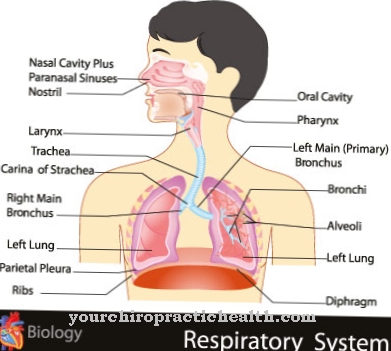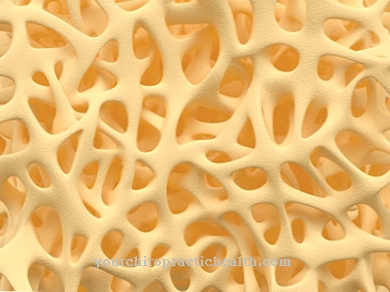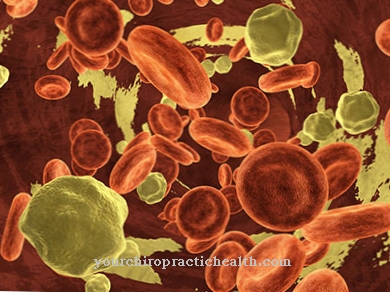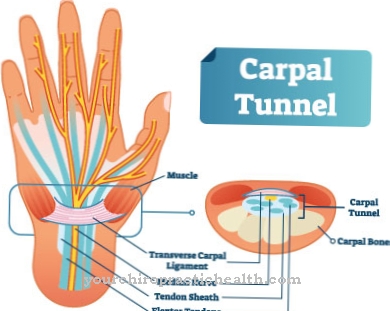The Runner's knees is also under the term Iliotibial band chafing syndrome, Tractus syndrome or iliotibial band syndrome and under the abbreviation ITBS known. The runner's knee is a painful disease on the outside of the knee that can occur in athletes and non-athletes.
What is a runner's knee?
.jpg)
© jivko - stock.adobe.com
The Runner's knees is caused by an incorrect strain on the knees when running. Overloading can also be the cause of the runner's knee. In runners' knees, pain occurs in the iliotibial tract, a tendon plate that extends from the thigh to the shin on the outside of the body.
In doing so, this tendon plate rubs against the knee joint and causes the pain. During this scrubbing process, tissue becomes inflamed and this can cause sharp pain. These pains on the outside of the knee joint first appear when walking downhill on a mountain or when jogging and can ultimately also be noticed when walking normally.
Marathon and long-distance runners are most affected by runners' knees, although non-athletes can also cause improper stress due to other causes and result in a runner's knee.
causes
Among the causes of the onset of pain Runner's knees count the known mistakes in running. If the warm-up phase is skipped or not stretched enough, the first causes of a runner's knee are laid. Often the causes of the runner's knee also lie in increasing the running training too quickly.
The wrong footwear is particularly often the cause of a runner's knee and running on too hard ground also contributes to the runner's knee. Another cause of a runner's knee is bow legs and other misalignments of the legs. Congenital malpositions are also a possible cause of a runner's knee.
Since the iliotibial tract runs from the pelvis over the outside of the thigh to the head of the tibia, any incorrect posture when running or walking affects the knee joint in the long term and can produce a runner's knee if the load is too high and for a long time. The runner's knee occurs when the iliotibial band is too short and rubs against the bone of the knee. The cause of the runner's knee can therefore also be a tendon injury.
Symptoms, ailments & signs
The runner's knee, also known as the iliotibial band syndrome, is characterized by severe knee pain that occurs particularly when the knees are stressed. It is sharp pain that is localized below the kneecap. Local inflammation of the tissue occurs there when the tendon plate on the outside of the thigh to the shin rubs over the bones of the knee joint.
Initially, the symptoms only appear when descending mountains. After a certain time, even smaller loads are enough to produce the sharp pain. These are then already noticeable during normal running or walking. In later phases of the iliotibial ligament syndrome, climbing stairs or bent legs while sitting cause discomfort.
Touching the kneecap can also cause severe pain. Sometimes bursitis also develops, which is also characterized by persistent severe pain, significant swelling of the knee joint, heat generation and restricted mobility. Furthermore, in the iliotibial ligament syndrome, joint effusion sometimes forms in the knee joint.
Another typical symptom is an audible crunch in the knee when moving. Basically, there is a good chance of recovery if the affected knee joints are spared. Then the symptoms subside within one to two weeks. However, if the knee joint is subjected to further stress, the cartilage can also be irreparably damaged and lead to the symptoms becoming chronic.
Course of disease
The course of the disease in Runner's knees begins with all discomforts associated with running, jogging or walking. If pain occurs in the knee, it should be handled with care. Since training errors are often the cause, if you are mindful of yourself, a lot is possible to prevent a runner's knee from the beginning.
Taking seriously advice on training speed and a soft running surface, suitable footwear and proper warm-up training are the best tools to counteract the progression of the disease in runners' knees. If the disease progresses, bandages must be used and training may temporarily no longer take place.
The frequency with which a runner's knee occurs is 28 percent of female runners and 24 percent of male runners. If the runner's knee continues to be stressed too heavily or incorrectly despite initial problems and pain, a chronically ill runner's knee can result.
Complications
As a rule, a runner's knee leads to very intense and uncomfortable pain in the first place. The painful are stabbing and have a very negative effect on the patient's quality of life. Furthermore, the pain can spread to other regions of the body, so that knee pain is not uncommon. Especially at night, the runner's knee can lead to sleep problems and depression.
It is not uncommon for those affected to be irritated due to the constant pain and suffer from mental disorders. The patient's extremities are warmed up by the runner's knee and often also swollen. It is not uncommon for the affected joints to bruise. In general, mobility restrictions also occur in the patient, which can make everyday life significantly more difficult. Strong complaints occur especially with stress.
As a rule, treatment can be done with the help of medication and does not lead to further complications. This can prevent inflammation. Furthermore, because of the runner's knee, the affected person is also dependent on therapies or massages in order to reduce the symptoms. The life expectancy of the patient is usually not reduced by the runner's knee. Obese people also have to reduce their body weight.
When should you go to the doctor?
A runner's knee is swelling and inflammation in the knee that mostly affects joggers and athletes. Normal movement is very difficult with a runner's knee. Even the slightest stress causes pain, so a visit to the doctor should not be delayed. In this context, inflammations often occur in the joints, which are easily visible to the human eye. At the first signs of such inflammation, a doctor should be consulted immediately.Otherwise, there is a risk of an abscess.
An abscess is a cavity that is filled with pus fluid. If this clinical picture remains without medical and drug treatment, there is even a risk of blood poisoning. If you have symptoms of a runner's knee, you should definitely see a doctor. A speedy healing can only take place through appropriate treatment. Whoever completely refrains from such treatment is putting himself at great risk. In the worst case scenario, permanent consequential damage can occur. The knee should be relieved so that joints, tendons and muscles are not further damaged.
Treatment & Therapy
A Runner's knees can be recognized in its initial stage by the pain. This is why this pain determines the therapy from the beginning. Cooling the knee and taking anti-inflammatory medication as well as a stabilizing bandage are the first steps in therapy for a runner's knee.
This includes absolutely protecting the knee. If the complaints with the runner's knee are particularly severe, the attending physician can also inject anesthetics. Then a break from running of up to three months may be necessary. Physiotherapy and a light advanced training course and specialist supervision are the next steps.
If you have too much body weight, you can reduce it. Because too much weight puts even more stress on a runner's knee. Therapeutic means for a runner's knee are massages and heat applications.
Outlook & forecast
The prognosis of the runner's knee depends on the extent of the existing disorders and the cooperation of the person concerned. Without the willingness of the patient to do something for his own health, there can be no good prospect of healing. If you are overweight, weight loss is essential for lasting relief from the symptoms. This can be achieved independently by the person concerned, with or without further medical treatment. However, working with a doctor will improve long-term and lasting success. In addition, possible complications are avoided.
If the runner's knee is the result of an incorrect load, physiotherapeutic treatment and the willingness of the person concerned to change can help to relieve symptoms. Movement sequences are optimized in targeted training and must also be implemented in a stable manner outside of therapy.
If the cause of the disease is knee overload, recovery can also be achieved if the patient introduces long-term changes in exercise capacity. Physiotherapy exercises and implementation of medical information about the functioning of the human organism and the joints must be carried out independently by the patient. If this is the case, a good forecast can often be made. If there are no further injuries or damage to the joint, healing is often achieved within a few weeks or months.
prevention
The preventive measures at Runner's knees are the correct warming up and stretching, suitable shoes and a soft running surface as well as the ideal weight. In addition, there is the attention to yourself when training.
Aftercare
The runner's knee usually leads to unpleasant and severe pain in those affected, which can sometimes drag on for a long time. That is why it is important for those affected to take it easy and to reduce sporting activities to a minimum. Training should be started cautiously to avoid relapse.
If the pain has spread to the surrounding regions of the body and causes additional disturbances, this can be enormously transferred to the psyche. Accompanying insomnia can cause those affected to be permanently irritated and suffer from fatigue. This can lead to depression and other mental illnesses. However, constructive discussions with friends and family can ensure that those affected deal more confidently with their suffering.
In addition to any follow-up checks by the treating doctor, it is important that those affected find distraction in their social environment and find joy in it. This may help them survive the idle time during the recovery process.
You can do that yourself
In the acute phase of the disease, cooling compresses have a pain-relieving effect; alternatively, pain-relieving ointments from the pharmacy can be applied. It is necessary to protect the runner's knee for at least two to six weeks, as otherwise chronic complaints can develop. Light running training may only be resumed once the symptoms have completely subsided. During this time, a bandage stabilizes the knee joint and supports healing.
When resuming training, make sure you warm up sufficiently, paying particular attention to the outside of the leg. Good footwear provides the necessary cushioning, misalignments of the feet can be compensated for with individually adapted insoles. Excessive increases in the amount of training and running on consistently hard ground often result in a recurrence of the iliotibial ligament syndrome. Shorter units on forest trails are much easier on the knees than long road runs.
If the runner's knee is due to excessive stress caused by an incorrect running style, expert advice and correction by an experienced running coach is advisable. In some cases it can be useful to replace part of the running training with other endurance sports such as cycling or swimming. In addition, the core and hip muscles should be strengthened and stabilized through targeted exercises in order to achieve an optimal sequence of movements when running.

















.jpg)







.jpg)


